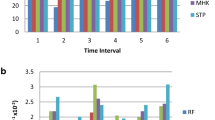Summary
The authors give a numerical solution of Ångström's equation for the extinction of solar radiation, where the procedure involves as variables: the intensityI of direct solar radiation, the optical air massm, the precipitable water contentw, and the Schüepp's turbidity coefficentB; given three of the above variables initially together with the wavelength exponenta as initial conditions, then the solution of Ångström's equation gives explicitly the fourth variable. In this form a complete description of the atmospheric turbidity is achieved.
Two large series of pyrheliometric observations made at Mexico City under very different sky conditions are used (1911–1928 and 1957–1962); the influence on turbidity values of haze, “smog”, fog and clouds is taken into account; the diurnal variation of atmospheric turbidity is also discussed; finally the great influence of volcanic eruptions on atmospheric turbidity is demonstrated.
Zusammenfassung
Die Verfasser geben eine numerische Lösung der Ångströmschen Formel für die Extinktion der Sonnenstrahlung. Diese Aufgabe umfaßt die folgenden Variablen: die IntensitätI der direkten Sonnenstrahlung, die optische Luftmassem, den Gesamtwassergehaltw und den Schüeppschen TrübungskoeffizientenB. Sind drei der genannten Variablen und dazu der Wellenlängenexponenta als Ausgangswerte bekannt, so läßt sich die vierte Variable der Ångströmschen Formel explizit berechnen und dadurch die vollständige Beschreibung der atmosphärischen Trübung erreichen.
Zu diesem Zwecke wurden zwei lange Serien von Pyrheliometerbeobachtungen benutzt, die unter sehr ungleichen Himmelsbedingungen in den Jahren 1911–1928 und 1957–1962 in Mexico City gewonnen wurden. Dabei wurde der Einfluß von Dunst, Smog, Nebel und Wolken auf die Trübungsgrößen sowie der Tagesgang der atmosphärischen Trübung untersucht. Zum Schluß wird der starke Einfluß von Vulkanausbrüchen auf die Lufttrübung nachgewiesen.
Similar content being viewed by others
References
Linke, F.: Transmissionskoeffizient und Trübungsfaktor. Beitr. Phys. fr. Atm.10, 91 (1922).
Ångström, A.: On the Atmospheric Transmission of Sun Radiation and on Dust in the Air, I, II. Geogr. Ann.11, 156 (1929);12, 130 (1929).
Schüepp, W.: Die Bestimmung der Komponenten der atmosphärischen Trübung aus Aktinometermessungen. Arch. Met. Geoph. Biokl., B,1, 257 (1949).
Volz, F.: Photometer mit Selen-Photoelement zur spektralen Messung der Sonnenstrahlung und zur Bestimmung der Wellenlängenabhängigkeit der Dunsttrübung. Arch. Met. Geoph. Biokl., B,10, 100 (1959).
Valko, P.: Vereinfachtes Auswerteverfahren für die Schüeppsche Methode zur Bestimmung der atmosphärischen Trübung. Arch. Met. Geoph. Biokl., B,11, 75 (1961).
Gorczynski, L.: Radiación Solar en Tacubaya, según las mediciones pirheliométricas desde 1911. Folletos Serv. Met. Mexicano SAG. Nos. 1–4 y núm. especial (1926, 1928, 1929, 1932).
Rayleigh, Lord: On the Transmission of Light through an Atmosphere Containing Small Particles in Suspension and on the Origin of the Blue of the Sky. Phil. Mag. (5)47, 375 (1899).
Smithsonian Meteorological Tables, Sixth Revised Ed., prepared byR. J.List, Table 142, pp. 429, and Table 144, pp. 431. Smithsonian Institution, Washington, 1951.
Möller, F.: Die Sonnenstrahlung und ihre Schwächung in der Atmosphäre, Kap. 6, in:F. Linke undF. Möller: Handbuch der Geophysik, Band VIII: Physik der Atmosphäre, I, pp. 262. Berlin, 1958.
Csagi: Manuel d'Instructions Météorologie, Instruments et Mesures de Rayonnement, pp. 11 et 18. Assoc. Int. Météorologie, U. I. G. G. Uccle, 1957.
Nicolet, M.: Sur la détermination du flux énergétique du rayonnement extraterrestre du soleil. Arch. Met. Geoph. Biokl., B,3, 208 (1951).
Schüepp, W.: Direct and Scattered Radiation Reaching the Earth. Ch. 4 in:N. Robinson: Solar Radiation, p. 111–160. Amsterdam—London—New York, 1966.
Widder, D. V.: Advanced Calculus, pp. 149, 1963.
Mie, G.: Beiträge zur Optik trüber Medien, speziell kolloidaler Metalllösungen. Ann. Phys.25, 377 (1908).
Junge, Chr. E.: Air Chemistry and Radioactivity, pp. 112. Internal. Geophys. Series, Vol. 4, 1963.
Bravo, H., A. P. Baez, yS. Lares: Estudio del depósito de polvo por gravedad en la Ciudad de México. Rev. Ing. Quím. (México), p. 26–28 (1960).
Robinson, N.: Solar Radiation, pp. 99, Ch. 4. Amsterdam—London—New York, 1966.
Bullrich, K., R. Eiden, R. Jaenicke, W. Nowak: Solar Radiation, Sky Radiation, Sky Leight Polarization and Aerosol Particle Total Number and Size Distribution on the Island Maui (Hawaii), Pure Appl. Geophys.69, 280 (1968).
McCormick, R. A., andJ. A. Ludwig: Climate Modification by Atmospheric Aerosols. Science156, 1358 (1967).
Valko, P.: Untersuchung über die vertikale Trübungsschichtung der Atmosphäre. Arch. Met. Geoph. Biokl., B,11, 143 (1961).
Mani, A., andO. Chacko: Measurements of Solar Radiation and Atmospheric Turbidity with Ångström Pyrheliometers and Poona and Delhi during the I. G. Y.. Indian J. Met. Geophys.14, 269 (1963).
Fischer, W. H.: Some Atmospheric Turbidity Measurements in Antarctica. J. Appl. Met.6, 958 (1967).
Galindo, I. G.: Estudio de la Radiación Solar durante el Año Geofísico Internacional. Monograf. Inst. Geofís. (México)3, 59 (1960).
Galindo, I. G.: Turbidometric Estimations in Mexico City Using the Volz Sun Photometer. Pure Appl. Geophys.60, 189 (1965).
Author information
Authors and Affiliations
Additional information
Instituto de Geofísica, Ciudad Universitaria, México, Publication No. 1011
With 9 Girues
Rights and permissions
About this article
Cite this article
Galindo, I.G., Muhlia, A. Contribution to the turbidity problem in Mexico City. Arch. Met. Geoph. Biokl. B. 18, 169–186 (1970). https://doi.org/10.1007/BF02243025
Received:
Issue Date:
DOI: https://doi.org/10.1007/BF02243025



